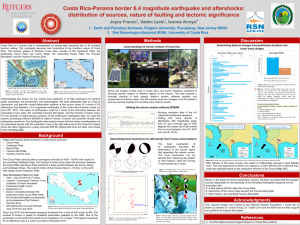Franco, Joyce: Costa Rica-Panama border 6.4 magnitude earthquake and aftershocks: distribution of sources, nature of faulting and tectonic significance
Title: Costa Rica-Panama border 6.4 magnitude earthquake and aftershocks:
distribution of sources, nature of faulting and tectonic significance
Name: Joyce Franco
Major: Geology
School affiliation: School of Arts and Sciences
Programs: Aresty – RA Program
Other contributors: Vadim Levin
Abstract: Costa Rica-Panama border 6.4 magnitude earthquake and aftershocks: distribution of sources, nature of faulting and tectonic significance.
Costa Rica is a country that is characterized by having high seismicity due to its complex tectonic setting. This complexity becomes less understood in the Southern region of Costa Rica. The tectonic setting of Southern Costa Rica consists of the Caribbean plate, the subducting Cocos plate and Cocos Ridge, the subducting Nazca plate, the Panama microplate and the Panama Fracture Zone. Understanding the factors for the current local seismicity is of high importance for general public awareness, the government and seismologists. We used earthquake data as a tool to understand and describe crustal deformation patterns at the source zones of a series of 52 aftershocks that followed a 6.4 magnitude earthquake at the Costa Rica-Panama border on June 26th,2019. The series of earthquakes could be a result of the interaction between the subducting Cocos plate, the overriding Panama microplate and the Panama Fracture Zone. For the purpose of improving the accuracy of the preliminary earthquake data, we used the seismic processing software SEISAN to select P-waves, S-waves and polarities directly from earthquake waveforms. Our earthquake data analysis shows that the series of earthquakes are not associated directly with the subduction zone or the right-lateral slip of the Panama fracture zone but rather triggered by a newly activated NW-SE striking fault zone and other minor faults in the overriding plate.
